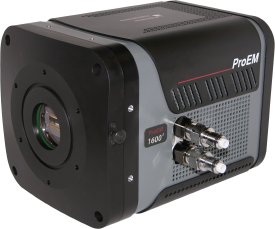Princeton Instruments is pleased to introduce the ProEM:1600, the most advanced spectroscopy EMCCD camera on the market to date.
The latest addition to the popular ProEM™ product line, this camera utilizes proprietary Princeton Instruments eXcelon™ technology, which greatly reduces the interference fringes (i.e., etaloning effect) that have made back-thinned EMCCDs unusable in the NIR until now. eXcelon also increases the sensitivity of the detector in the UV, blue, and NIR spectral regions.

The eXcelon-enabled ProEM:1600 EMCCD camera features 16 micron pixels in both 1600 x 200 and 1600 x 400 formats. The ProEM:1600 has a high-speed, electron-multiplying (EM) mode capable of capturing fast dynamics as well as a traditional CCD mode that delivers ultralow read noise for high-precision photometry. The new camera’s 6.67 MHz readout rate and 1.5 ìs vertical shift time allow acquisition rates of over 3000 spectra per second, outpacing any other available spectroscopy-format EMCCD camera by more than 2x.
“Among the primary applications of the ProEM:1600 camera are scanning confocal Raman spectroscopy, hyperspectral imaging, and single-molecule spectroscopy,” explains Ed Gooding, Ph.D., spectroscopy product manager at Princeton Instruments. “Every element of the ProEM:1600 has been optimized to make life easier for spectroscopists, including a new software feature that virtually eliminates frame-to-frame instability even at the highest spectral rates.”
The new ProEM:1600 EMCCD camera for spectroscopy also provides the same highly innovative features that have already become hallmarks of the ProEM platform, including a Bias Active Stability Engine (BASE™), Princeton Instruments Noise Suppression (PINS™) technology, and OptiCAL™ — on-demand EM gain calibration via a built-in light source. A hardware-generated timestamp on each frame, meanwhile, takes the guesswork out of time-resolved photometry.
The camera’s advanced, all-metal-seal vacuum design delivers deep thermoelectric cooling and low dark current. Vacuum performance is guaranteed for the lifetime of the camera, the only such guarantee in the industry. The ProEM:1600 is cooled with air, liquid, or a combination of the two. For vibration-sensitive applications, maximum cooling can be achieved using liquid recirculation, eliminating fanvibration.
The latest Gigabit Ethernet (GigE) interface allows remote operation of the new camera via a single cable without the need for custom frame grabbers. The ProEM:1600 operates on 32-bit and 64-bit Microsoft® Windows® operating systems and is fully supported under LightField™, Princeton Instruments’ advanced 64-bit data acquisition software featuring the patent-pending IntelliCal™ spectral calibration routine.